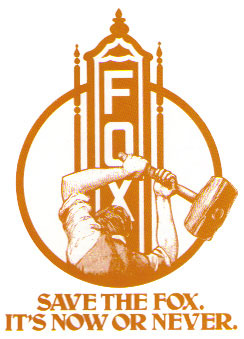

By Hal Doby
Originally written, March 1996, last revision: January 24, 2017
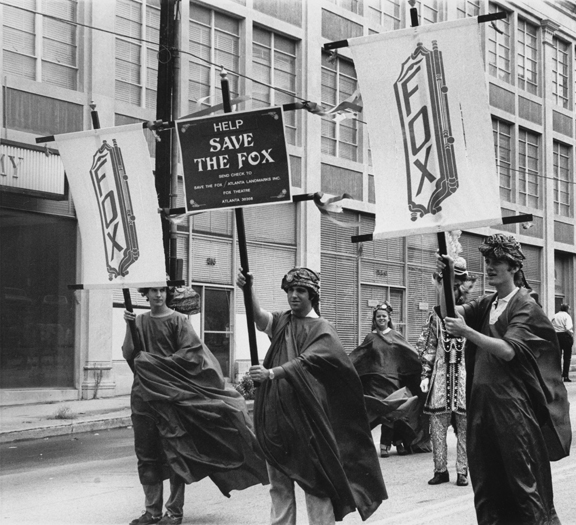 On January 2nd, 1975, The Fox Theatre was scheduled to finally be
shuttered
after the 9:25pm showing of the Richard Burton / Lee Marvin /
O.J. Simpson film, "The Klansmen".
almost all of the people that showed up for the last show were there out of shear love for the building.
After the movie, general manager Mike Spirtous took those who
were interested in a last tour of the building. Once the tour was
concluded and the patrons shown the exit door, the lights were turned
off and the doors were locked for what was thought to be the
final time.
On January 2nd, 1975, The Fox Theatre was scheduled to finally be
shuttered
after the 9:25pm showing of the Richard Burton / Lee Marvin /
O.J. Simpson film, "The Klansmen".
almost all of the people that showed up for the last show were there out of shear love for the building.
After the movie, general manager Mike Spirtous took those who
were interested in a last tour of the building. Once the tour was
concluded and the patrons shown the exit door, the lights were turned
off and the doors were locked for what was thought to be the
final time.  This
is where I need to stop and talk about Southern Bell.
Many
people saw Southern Bell and Mosque, Inc. as the
villians in this
situation.
That was far from the truth. Mosque had been loosing money from
the
operation of the Fox for a number of years and like any business, they
wanted to cut their
losses. Granted, it did make a profit in 1973 and 1974, but
that was seen by
Mosque as somewhat of a fluke and they expected that
would be short-lived. Since no one had shown interest
in large
theaters, Mosque felt the only way to rid themselves of the Fox,
was to sell it as a noting more than real estate. Thus in their minds, the
building had to be razed in order to make way for a new structure.
This
is where I need to stop and talk about Southern Bell.
Many
people saw Southern Bell and Mosque, Inc. as the
villians in this
situation.
That was far from the truth. Mosque had been loosing money from
the
operation of the Fox for a number of years and like any business, they
wanted to cut their
losses. Granted, it did make a profit in 1973 and 1974, but
that was seen by
Mosque as somewhat of a fluke and they expected that
would be short-lived. Since no one had shown interest
in large
theaters, Mosque felt the only way to rid themselves of the Fox,
was to sell it as a noting more than real estate. Thus in their minds, the
building had to be razed in order to make way for a new structure.
Between the 1950s and the mid-1970s, Movie Palaces were seen as relics of the past. Many felt they had no real historic or architectural importance. A lot of people at that time did not care if they were saved or torn down. There was no effort on anyone's part to save any of the other movie houses in Atlanta before the Fox was in peril. Mosque approached Southern Bell to buy the Fox, Mosque convinced Southern Bell that razing the Fox was in the best interests of everyone, including the City of Atlanta.
From this, you might think that I am making Mosque, Inc.into the villian of this story. In some ways, perhaps year, but in others, they were only doing what many others had done in past decades around the country. There were thousands of theaters in the downtown districts across the nation and hundreds that could be considered to be true movie palaces. By 1975, thousands of theaters had been razed and there were now under 200 palaces that still stood. There were 5 theaters in William Fox's chain of theaters that are now called the "Super-Foxes". The San Francisco Fox was razed in 1963 to make way for a grocery store and the Brooklyn Fox was shuttered in 1968, then razed in 1970 to make way for an office building. While people lamented the loss of palaces around the country, not much of a public outcry was made on their behalf to save them.
While Mosque was villified, it was even worse for Southern Bell. They found themselves in what was becoming a terrible publicity situation. Hundreds of people were sending their bills with "Save The Fox!" written on the bills and their checks. People began to picket Southern Bell offices, Protest lines were continually lined up in front of the Fox on Peachtree Street. In all fairness to Southern Bell, once they realized that people were passionate about saving the Fox, they wanted to do everything they could to save the Fox while at the same time, still getting their new headquarters and minimizing their losses from the debacle.
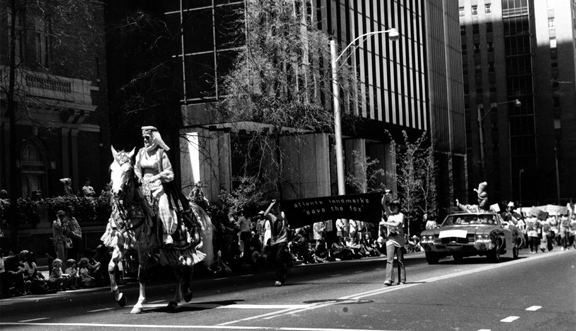

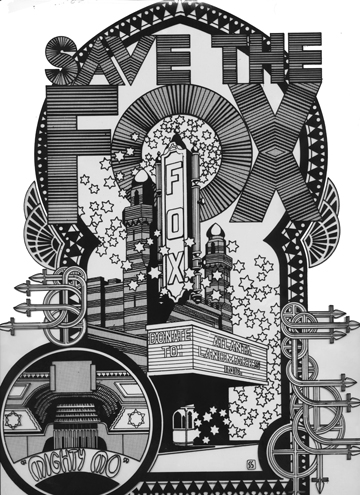
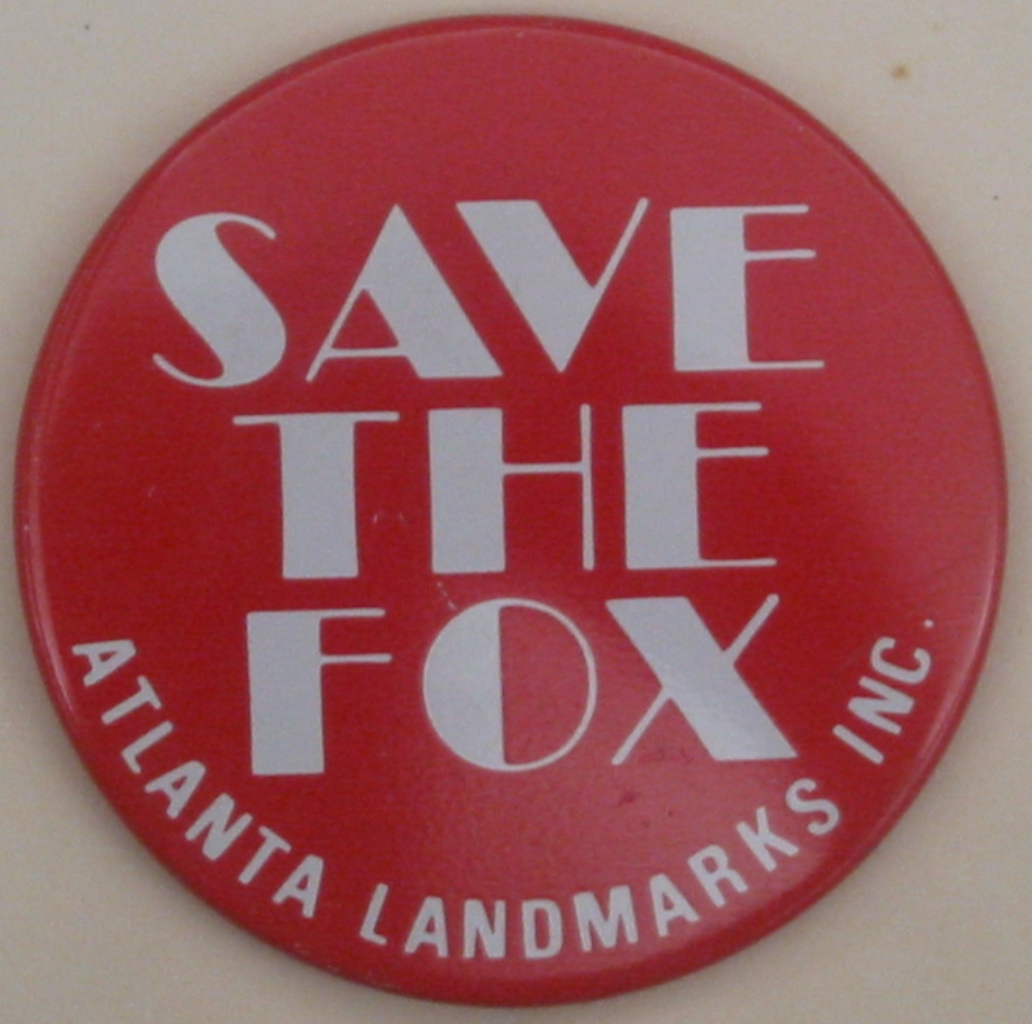 Joe Patten, along with his
friend Robert L. Foreman Jr., and their associates were hard at work trying to
come up with a way to save the Fox. They privately met with Atlanta Mayor Maynard Jackson.
During the meeting, Mayor Jackson agreed to suspend the
demolition permit for six months in order for them to
organize and
come up with a plan that would save the Fox. After the meeting, they formed Atlanta Landmarks, Inc, a
non-profit organization dedicated to the preservation of Atlanta's
architectural treasures.
Joe Patten, along with his
friend Robert L. Foreman Jr., and their associates were hard at work trying to
come up with a way to save the Fox. They privately met with Atlanta Mayor Maynard Jackson.
During the meeting, Mayor Jackson agreed to suspend the
demolition permit for six months in order for them to
organize and
come up with a plan that would save the Fox. After the meeting, they formed Atlanta Landmarks, Inc, a
non-profit organization dedicated to the preservation of Atlanta's
architectural treasures. After a lot of research, a creative deal was conceived and agreed upon by the City, Southern Bell, MARTA, and Atlanta Landmarks. Southern Bell had wanted to aquire the entire city block. the Fox sat on one-quarter of that property. Southern Bell had purchased the Fox, but when the public outcry to save the Fox began, Southern Bell stopped dead in its tracks and suspended its actions to purchase the rest of the property. Part of that area had been scheduled to be dug up by MARTA (the Metro Atlanta Rapid Transit Authority) in order to construct its North-South light transit rail system that was going to run underground below the Downtown and Midtown areas.
Robert Foreman Jr. came up with the idea of Atlanta Landmarks purchasing the other 75% of the "Fox Block" and offer Sourther Bell a simple land swap. But it was not a straight-forward process which is why Southern Bell had not already purchased the rest of the block. Upon investigation, the remaining property was composed of around 18 individual tracts of land, owned by several different people and companies that were spread out all over the United States and Europe.
Foremand and Atlanta Landmarks was able to negotiate and arrange the purchase of the properties for slightly over one and a half million dollars. With Atlanta Landmarks "owning" the remaining 75% of the block, Southern Bell was quite willing and eager to exchange the deed the Fox in return for the deeds for the rest of the block. By making what turned out to be some very minor alterations to thier plans, Southern Bell would be able to build their headquarters with a portion of it directly on top of the MARTA lines. Ironically, the property next to the Fox would now be an open air parking lot, which was to have been the fate of the Fox property!

As the land swap deal was being worked out, the feesability study was completed and presented to the City and the public. The report concluded that the Fox could not only survive and pay for itself, but it could also make a modest profit if it were run as a non-profit omnibus center for performing arts. Instead of just movies, it would present a wide range of offerings such as opera, ballet, theater, pop music concerts, and last but not least, movies. The Fox could make its way to profitability. Everyone took a deep breath and rejoiced!
The final issue was to figuring out how to fund the one and a half million dollar purchase of the property. First National Bank of Atlanta, Citizens & Southern, Trust Company Bank of Atlanta, National Bank of Georgia, and Georgia Federal Savings agreed to come together and loan Atlanta Landmarks the needed money. While each bank could have easily afforded to loan that amount, it was decided that by spreading the liability across all five banks, should Atlanta Landmarks fail, it would not result in a catastrophic failure to a single bank.
Like any other mortgage, there had to be collateral. After all, Atlanta Landmarks was nothing more than a brand new group of citizens with no history or experience in theater management. To the rescue came Southern Bell, who agreed to co-sign the note and guarrantee any lost interest payments. Finally Mosque, Inc. agreed to also co-sign and use the deed to the Fox as collateral. The loan was formalized and the properties were assigned to their new owners on June 25, 1975.
The final purchase price of the remaining property on the "Fox Block" was 1.8 million dollars. Atlanta Landmarks agreed to pay off the loan in one single payment, due in three years. There would be interest payments every three months of approximately $360,000, starting in June of 1976. The loan was made with the very strict understanding that each payment had to be paid exactly on time. Should one payment be missed in as little as one day, the Fox would be instantly foreclosed upon and in a matter of days, the suspended demolision permit would be re-approved and the building razed. It was estimated should that had happened, the Fox would have been wiped away in under a month's time! While many today may find that strict timeline impossible or a scare tactic, this indeed was the case.
By my estimates, Atlanta Landmarks paid approximately $2,520,000 with the seven interest payments. The final payment for the principle was 1,800,00. All told, the final purchase price of the Fox Theatre, including interest, closing costs and legal fees totaled just shy of 5 million dollars.
Atlanta Landmarks took possession of the Fox the same day the loan was closed. Because it had only ceased operation under seven months prior, plus the Fox's sound structural design, there were less things wrong with the Fox than there were right, it did not take a long amount of time to return the Fox to an operational status. With Ted Stevens as the Fox's new General Manager, The Fox opened its doors to the public on September 14, 1975 when the American Institute of Architects sponsored a public tour of the Fox as a fundraiser for Atlanta Landmarks. People flocked to see the Fox and over 4,000 people lined up for the tours, which took about three hours to complete. Finally, on October 29, 1975 the Fox commenced regular performances with the first event being a benefit concert for the Fox by Linda Ronstadt. From that that day forward day, the Fox has always remained profitable!
Benefit concerts were regularly held along with movies and fund raising events such as tours of the complex. Before and after events, Atlanta Landmarks volunteers would stand in various places with buckets so people could donate money to go toward saving the building. Performers such as Linda Ronstadt, Jack Benny, Liberace, Kate Smith, Lynard Skynard, Helen Hayes, Mitzi Gaynor, Cloris Leachman, Van Cliburn, Arthur Fiedler, and many others gave benefit performances and donated their time to help the "Save the Fox" campaign. As a regular staff member at the Fox during performances, I can't remember a concert where the performer would stop and say "I can't believe they were going to tear down this place!"
At first, no one in the Atlanta Landmarks organization had ever undertaken an effort like Save the Fox. Everybody was scared to death over the strict loan agreement. The threat of missed interest payment and then sudden demolision of the Fox was very real. As the first interest payment approached, the Fox was standing on its own two feet and it was readily apparant the citizens of Atlanta were not going to let the Fox down. This went beyond donating money as people would simply show up at the doors and ask "what can I do to help?" People volunteered time and skills to help bring back the Fox back to a better condition. I was one of those people and I soon found myself doing all sorts of labor-intensive odd jobs. I painted hand rails, scraped glued-down carpeting off of cement amd tiled floors, removed drop-ceilings that had been put up when some rooms were used as GTC offices, and boy I did a lot of painting!
1976 was the year the United States celebrated it bicentennial of its revolutionary war and its founding. As part of that celebration Prince Charles of England made a public appearance in the United States and planned a visit to Atlanta. As part of the festivities, a grand banquet was planned to be held in the Egyptian Ballroom of the Fox. To help prepare for this momentus occassion, Ted Stevens asked his friend Rick Flinn to come to the Fox and help with the preperations. Rick's help was invaluable and once the event transpired, he was invited to join the Fox Staff on a permanent basis. Thus he was given the title of the Fox's first Restoration Director. He served in that position for over 18 years.
In 1977, Ted Stevens stepped down as General Manager and was replaced by Alan McCracken who served as GM until 1981. Members of the International Brotherhood of Electrical Workers (I.B.E.W.) volunteered time and materials to help renovate the Fox Theatre's electrical service. Volunteers of the Atlanta Technical School begin to volunteer services to help the Fox as well.
All of this hard work was paying off. Each of the interest payments were easily met ahead of time. As for the big looming principal payment, the money was being raised to take care of that too. At the start of 1978, there were a large number of challenge pledges that had been made which amounted to a lot of money. Beachamp Carr contacted the challenge sponsors with the news that on paper, their challenges had been met and it was time to pay up. To their credit, every pledge was quickly made and on February 27th, 1978, the Fox's mortgage was completely paid off. Finally, the Fox was indeed saved! Hector Olivia, a renown organist, was going to give an organ concert as a benefit to the Fox, he was allowed to make the public announcement of this great achievement.